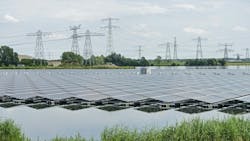At the end of April, a massive blackout swept through parts of Europe, centered in Spain. While early media coverage fixated on a lack of inertia, the Spanish government later clarified that the primary issues were related to visibility and control of inverter-based resources. The final report with the detailed analysis is still pending, so the real root causes are still unknown. Still, the role of inertia, both natural and synthetic, remains a critical design question for grid operators.
Inertia is a term all engineers learn in Introduction to Engineering. Like friction, it’s a concept they can usually explain to non-engineers. But quantifying how much inertia is needed to keep the grid stable is another matter. Even among the engineers studying it, there’s debate over how to calculate these values, particularly as new sources like grid-forming inverters enter the mix. There are competing models of how to calculate values, and several peer reviewed papers that offer different answers to those questions.
So why was the lack of inertia being blamed? About 70% of generation came from inverter-based resources (IBRs), which provide less inertia than synchronous machines. Plus, most synchronous generation was offline that mild spring day.
What the media missed were other forms of inertia — load-side motors, pumped hydro, and even IBRs themselves. These are often overlooked. While we don’t have the full data picture, some snippets suggest:
- The load was dropping during the lunch period
- Solar output hit a 2025 record just before the event
- Grid voltage was reported high at the time
One hypothetical scenario — unconfirmed by the Spanish report but technically plausible — is that voltage remained elevated beyond overvoltage relay thresholds. Inertia may have delayed the system’s response just long enough to trip protection. If substation load and nearby generation were lost, it could have triggered a cascading failure. Though recent findings emphasize visibility and control of IBRs, this possibility shows how inertia — typically stabilizing — can under certain conditions act as a destabilizer. FERC Order 901 and NERC’s efforts rightly focus on IBRs, but we must also model synthetic and load-side inertia more rigorously.
A recent NERC alert makes clear: we still lack accurate grid models. As we redesign the grid, we need to understand the transient and dynamics of each source and there impacts, including inertia. Are synchronous condensers and new protection schemes part of the future? How much synthetic inertia can we draw from storage and grid-forming inverters? Can we turn off inertia when needed, and when is that time? What high-speed controls will we need? Should 10% of ALL generation be reserved for primary frequency response? Can operators adjust sources from 1 kW to multi-gigawatt plants in real time?
There have been eight other blue-sky blackouts globally in 2025. Fixing our models and understanding these dynamics is critical to future grid stability.
Early Findings
In June, the Spanish government reported that while solar wasn’t the root cause, it was a major contributor — particularly due to issues with interconnection, control, and visibility.
The report is short on details. It mentions control problems before the blackout and sudden losses of distributed generation (117 MW in one case). Curtailment wasn’t cited, but visibility and solar loss were mentioned repeatedly.
The ENTSO-E investigation is still ongoing, but Spain’s report suggests several urgent actions for North America:
- Full system visibility: All interconnections must be visible to DSOs or TSOs in real time.
- Dynamic modeling: Owners/installers must provide transient and dynamic system models. Inverter manufacturers must supply models to operators.
- Operator control: DSOs/TSOs must be able to curtail generation and change power angles directly.
- Inclusive rules: Apply to all, including storage, wind, and limited/no-export systems.
- Pre-approval of changes: Active component updates must be approved with updated models.
- Ride-through and relay standards: All systems must have utility-grade relays and ride-through capability, with <2 seconds of inadvertent export.
- Accountability: Systems must respond to control commands — or owners bear liability.
- Frequency response: All systems must support primary frequency response.
The DOE should be funded to test inverter behavior, and state commissions should revisit interconnection rules. AHJ inspectors need stronger training, and installers should be licensed for commissioning systems.
These measures may sound demanding — but if we’re serious about a zero-carbon grid, they’re not optional. They’re essential.
About the Author
Doug Houseman
Doug Houseman is a veteran of the industry, with many years of experience in the global industry. He has spent the last 4 decades consulting on T&D related issues. Doug is a managing consultant for 1898 & Co. He is a senior member of IEEE and a very active member of the Power and Energy Society. His work spans more than 50 countries and more than 200 utilities.
